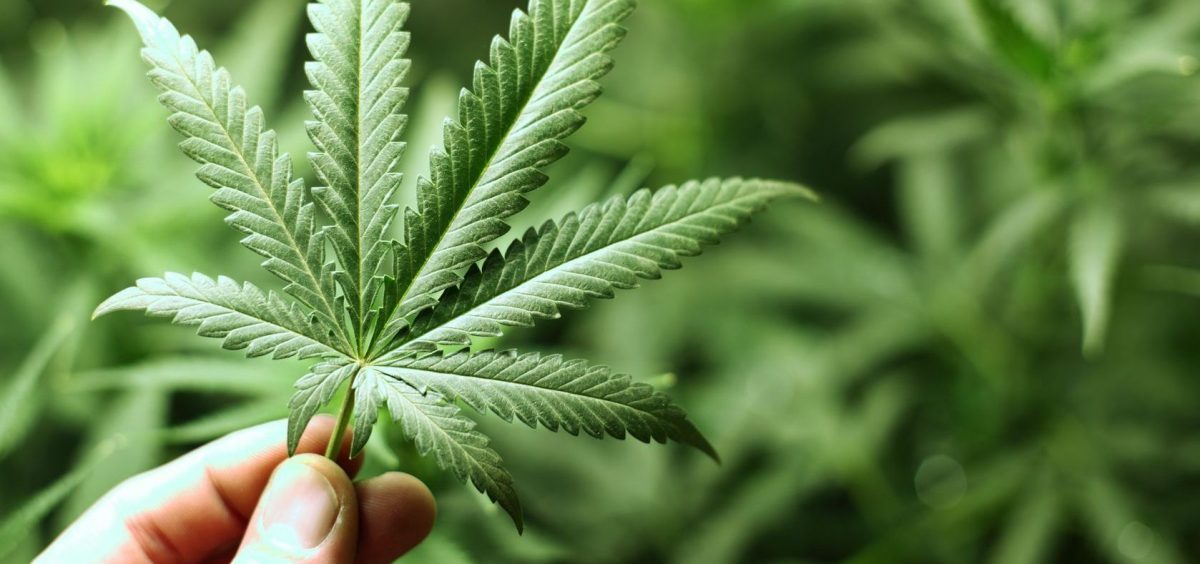
Medical Marijuana: How SE Ohio Plays a Unique Role in its Growth
By: August Knuth, Madison Staley, Nick Mullens
Posted on:
Cannabis– it’s a plant that’s been around long before our time. Cannabis was likely discovered around 500 B.C., according to History.com, and its uses ranged from healing practices and religious ceremonies to making things like textiles and rope.
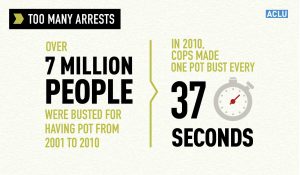
Early colonists relied on cannabis to aid in their everyday life and it has a strong presence throughout history. In the 1800’s cannabis could even be found in pharmacies and doctors’ offices to treat a variety of ailments.
It wasn’t until the 20th century that the plant developed a bad reputation, because of political and social factors. And, by the 1930’s there was a law in place that banned sales and use of cannabis, The Marijuana Tax Act of 1937. Medicinal marijuana was still legal under this law, but it was heavily taxed.
Since then the debate has grown–is marijuana a ‘gateway’ drug to more serious, addictive drugs, or no more harmful than alcohol? Legally it was treated as no different than cocaine or heroin, and in fact, in 2010 more than half of drug arrests in America involved marijuana. A majority of those arrests were simply for possession, according to the ACLU.
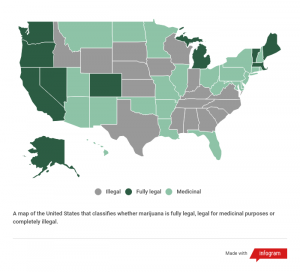
But, now the narrative seems to be changing. Today, 28 out of the 50 states in the U.S. have legalized medicinal marijuana to some degree. And, 10 states plus
This drastic change in view toward the drug may have something to do with the economic and medical benefits that Cannabis has the potential to deliver. Marijuana brings the possibility to make a positive impact right here, in Southeast Ohio.
But, now the narrative seems to be completely changing. Today, 28 out of the 50 states in America have legalized medicinal marijuana to some degree. And, 10 states plus Washington D.C. have gone so far as to make the drug legal for recreational purposes.

Ohio jumped on the bandwagon to legalize marijuana for medicinal purposes on September 8, 2016 and created a list of 21 conditions that qualify for its use.
This drastic change in attitude toward the drug may have something to do with the economic and medical benefits that Cannabis has the potential to deliver. Marijuana brings the possibility of making a positive impact right here, in Southeast Ohio.
Legal Marijuana: A Multi-billion Dollar Industry
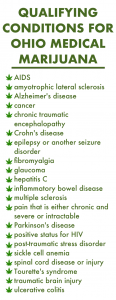
In 2018 the legal marijuana industry (medicinal and recreational) grew to $10.4 billion dollars, according to a Fortune Magazine article. The industry employs more than 250,000 people in the United States.
Salaries for jobs in cultivation, extraction, retail and ancillary businesses range from $22,000 to $300,000, according to the jobs and salary database, Glassdoor.
The industry in Ohio can expect to grow as more people are able to obtain medicinal marijuana. Right now, there are 21 conditions that qualify someone to obtain medicinal marijuana with a doctor’s recommendation.
According to Dr. Dhiraj Vattem, a Principal Investigator for the Edison Biotechnology Institute at Ohio University, as more research is conducted, the list may expand to the benefit of the economy and medical research.
“That list is bound to grow, yes, absolutely,” Vattem said. “And that is the case with any natural product, any new drug coming out on the market. The good thing here being because there is a growing economic industry in billions of dollars, close to 32 billion dollars or something like that. Some of the revenue can be put back into research to actually double up more scientifically backed products.”
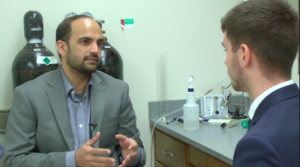
Southeast Ohio may also have a lot to gain because of this growing industry.
“Whether it’s as growers, or as processors, or as dispensary people,” Vattem said. “It will offset some of the economic decline that they have seen because of the fallen coal industry. So I think it has a lot of potential for economic benefit in Appalachia, especially in the Southeastern Ohio region.”
Dr. Jonathan Cachat, the Director of Laboratory Sciences and Undergraduate Research at Hocking College, agrees with Vattem when it comes to the economic opportunities medical marijuana can bring to the state of Ohio, as well as his lab.
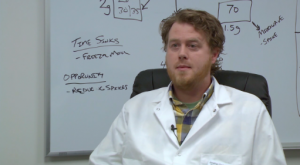
“Within a year or so, all of those operations are allowed to double in size if the state allows,” Cachat said. “So that means another round of 10, another round of 50 people just getting hired to work at these places. By the time that happens too, hopefully Hocking will have its first round of graduates and it would mean more business for the lab in general.”
Hocking College will offer the first in the nation associate degree in Cannabis Lab Technician starting in the fall. All of this expected growth is going to take some time though, especially here in Southeast Ohio.
Process to get Medicinal Cannabis
Whether it is obtaining medicinal marijuana as a researcher, or applying to become a testing lab for medical marijuana, the process is a lot of work combined with months of waiting. Cachat’s application for Hocking College’s testing lab was more than 300 pages.
“I don’t wanna say it was easy because it was far from easy,” Cachat said. “You know it was basically six months of me writing out this entire application.”
Cachat said after submitting the application, the work was over. From there, it just became a waiting game between him and the state.
“We were supposed to know within a couple months,” he said. “It ended up being 10 months where we just didn’t even know if we were gonna get a provisional license.”
Cachet was no stranger to the difficult process of obtaining cannabis. In graduate school, Cachat quickly noticed it was easy for him to receive almost any Schedule I drug, aside from cannabis.
“LSD and MDMA, I could get those in a two day shipping, no problem,” Cachat said. “But, when I wanted to get cannabis it was sort of its own special, Schedule I.”
Dr. Vattem had similar problems trying to gain access to cannabis for his research at Ohio University.
“It took me about a year to actually get the DEA registration and several months after that before I actually got cannabis from NETA.” Vattem said. “It is a very complicated process. It requires extensive criminal background checks and documentation.”
The difficulty of obtaining cannabis for research or testing is a result of its Schedule I classification. When a drug falls under Schedule I, it means that the drug is at a high risk of being abused.
Vattem said once cannabis is revised, or reclassified, there will be an “explosion” in cannabis research. However, until that happens, he is thankful he went through the application process and is on the forefront of it all.
“Absolutely, it was worth it, “ he said. “Because there are very few investigators in the whole U.S., who have the ability to work on Schedule I substances, and I’m glad, however difficult it was.”
Testing and Researching in Southeast Ohio
While medical marijuana dispensaries are popping up all over Central and Northeast Ohio, the Southeast portion of the state has dived into the research and testing of the medical marijuana, especially at Hocking College and Ohio University.
Hocking College is provisionally licensed as a medical cannabis testing lab. Dr. Cachat has gone one step further and helped develop curriculum for the first associate degree program for Cannabis Lab Technicians, providing lab techs for other testing facilities across the country.
“Being the nation’s first 2-year associate degree with cannabis as a major, cannabis lab tech, is a pretty enormous step,” Cachat said. “No other universities have gone this far…I’m just glad I found a university that wanted to carry the flag and let me run it across the finish line.”
The curriculum will be based around three things: the business and economics of cannabis, the cultivation process, and of course, the chemistry.
The interest in the program has been wide ranging from other institutions. Cachat received calls from Canada, West Virginia, Kentucky, and other community colleges wanting to understand how they can implement cannabis into their lab curriculum.
While Cachat’s lab will be focusing on testing the medicinal cannabis that hits the shelves at dispensaries and teaching students to eventually fill that role as well, as Ohio University Dr. Vattem is studying how medicinal marijuana can impact neurodegenerative diseases.
Vattem has been studying how cannabis can slow down the effects of diseases, such as Parkinson’s and Alzheimer’s. He uses fruit flies and nematodes (a worm model) to conduct this research.
“It’s too early to say, but, initial results do show some positive effect,” Vattem said. “We are seeing a delay in the onset of the neurodegenerative symptoms and also a prolongation in their lifespan associated with it.”
With the opioid crisis in full effect, people are looking for a alternative remedies for chronic and severe pain. Medical marijuana shows potential that it could help solve this problem.
“Other doctors though, understand that it is a safer option,” Cachat said. “And they think, I would like to at least have it in my toolbox. I’ve got a toolbox of all these pills, I can just add one more thing that might work better.”
Future of Research

Cachat believes his Hocking program is just the start of what the future of cannabis can bring.
“We’re just now beginning to understand and appreciate the therapeutic value that is in this plant,” he said. “This program represents a path to prosperity that you might have considered- you know- didn’t even exist before. So, there is certainly tons of interest locally and nationally for people wanting to be a part of the first.”
Vattem said it’s too early tell whether or not medical marijuana is going to have a real impact on reducing opioid related deaths, but it is certainly something that needs to be pursued by researchers.
“My lab studies some aspect of that,” Vattem said. “We do work on how it relates to inflammation and pain, and how cannabis can potentially have a positive effect on that. But, I’m not comfortable in saying that it’s actually going to really decrease opioid death.”
However, even though all doctors may not have the same outlook, Cachet believes medical marijuana can have a positive impact on the the opioid crisis.
“It’s kind of a double edged sword,” Cachat said. “Doctors have become so micromanaged with these pain medications, and a number that I talked to don’t even wanna get into cannabis, don’t even wanna get into that mess”
“There are all sorts of things that medical marijuana is approved for,” he said. “We just need stronger scientific evidence to back it up. So, that’s what I keep reiterating on and that’s what our purpose is.”

